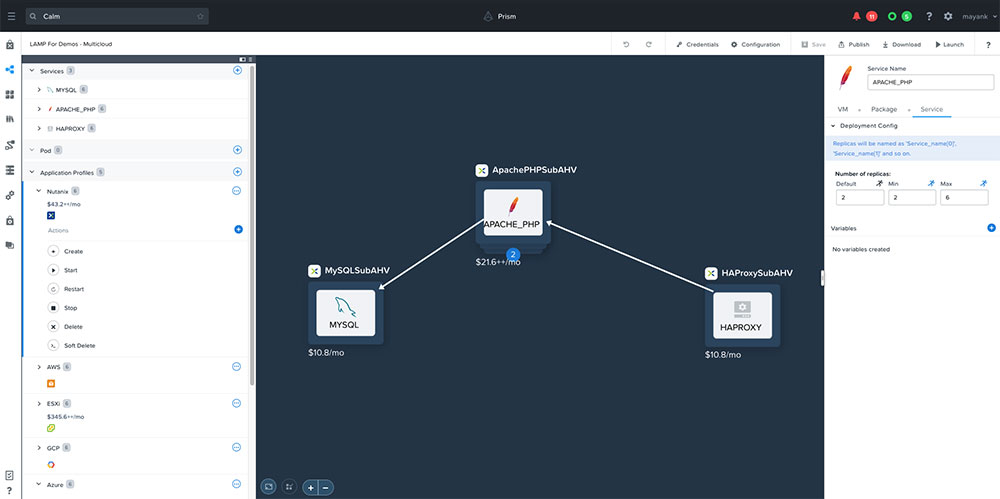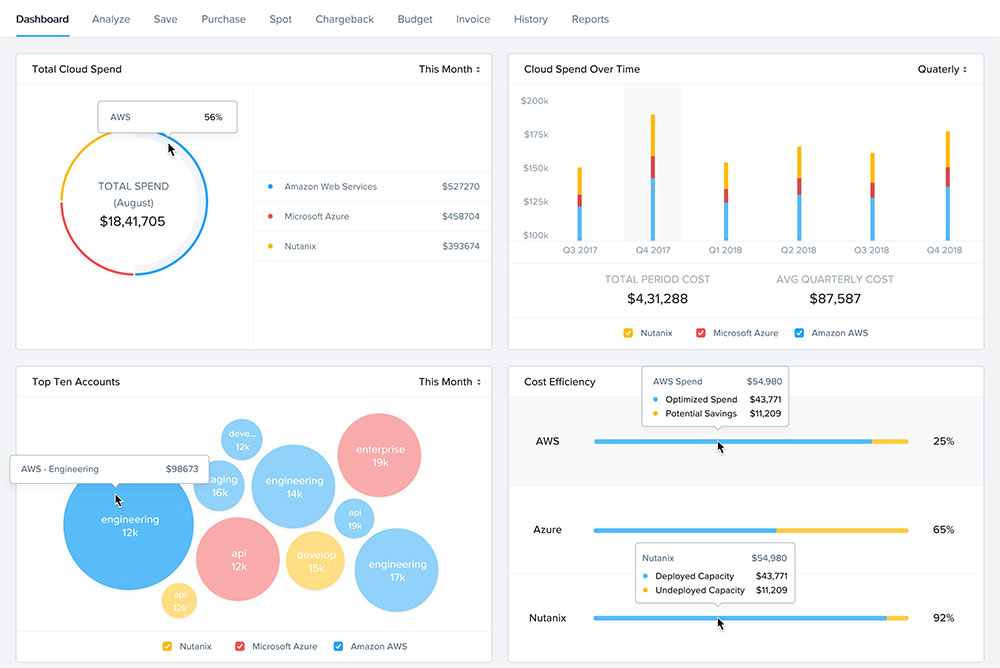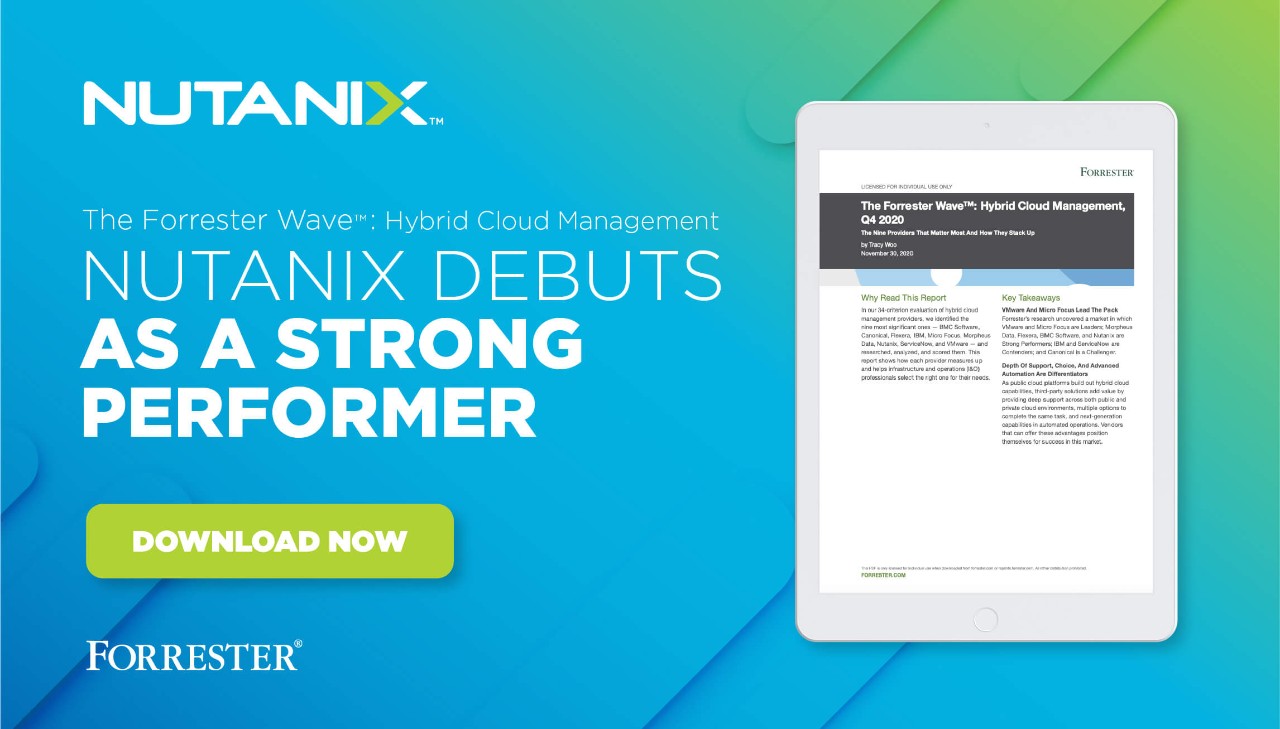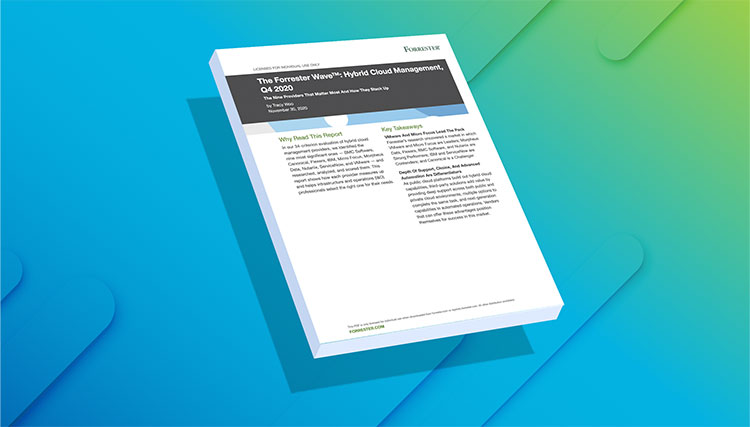Nutanix Debuts as a Strong Performer in Forrester’s Hybrid Cloud Management Wave
Nutanix, a relatively new entrant in this market segment, was invited to participate in The Forrester Wave™: Hybrid Cloud Management, Q4 2020. Forrester used 34 criteria to evaluate various solutions in the HCM Wave and we are delighted to be included as a Strong Performer in our first year of participation. Forrester defines Hybrid Cloud Management (HCM) as a software stack that delivers governance, visibility, lifecycle management, and optimization insights across multiple clouds including both public and private environments.
At Nutanix we provide two products - Calm and Xi Beam - that deliver the functionality needed to manage a hybrid cloud environment with a solution that’s easy to implement and use. Our analysis of the report suggests that while some vendors included in this report include a wider array of products that comprise their HCM solution, the Nutanix HCM focuses on providing more in-depth support for the most commonly used features that enterprise customers need to manage their applications and data in hybrid clouds.
Why Hybrid Cloud Management? It’s All about Automation, Controlling Costs, and Security.
Organizations running workloads in multiple public clouds in addition to their own private clouds need to automate tasks, manage costs, and enforce security policies with a single tool.
Without this tooling, IT and cloud teams would need to manage multiple proprietary toolsets and operating models for each environment; this adds cost, slows deployment, and increases errors. With an easy to deploy package, Nutanix helps customers get the most value from their HCM solution quickly along with a broad choice of commercial models to suit their needs.
The key capabilities that the Nutanix HCM solution focuses on include:
- Application provisioning and orchestration
- Cost visibility and predictive analytics
- Security policy creation and enforcement
Application provisioning and orchestration with Calm
Calm automates various aspects of the application lifecycle, such as provisioning, scaling, and cleanup, by creating simple blueprints for these actions. These blueprints can be created through the Calm UI, or with a Python-based Domain Specific Language (DSL), to truly enable Infrastructure-as-Code and Application-as-Code deployments. Calm users begin by automating common application lifecycle activities, grow into multi-step processes, and eventually design complex blueprints that span multiple environments (VMs or kubernetes containers), multiple clouds (AWS, Azure, GCP, or private cloud), and across multiple teams.

Application Provisioning and Orchestration with Nutanix Calm
Cost visibility and predictive analytics with Beam
As IT teams grow their hybrid cloud adoption, it becomes essential to implement policies that control unwarranted consumption. Beam helps address this challenge with unified cost visibility, billing, and predictive analytics that optimize cloud spending. Customers get accurate and out-of-the-box cost metering for private cloud resources (such as VMs, snapshots, etc.) running in their datacenter. Highly customizable reports provide spending visibility across various teams, business units, or applications, along with chargeback capabilities. And customers get cost optimization recommendations that can lower overall cloud spend by 35 percent or more!

Cost Visibility and Predictive Analytics with Beam
Security policy creation and enforcement
To ensure that your cloud teams are following security best-practices, cloud admins need to first implement a security baseline based on their organization’s risk appetite. Nutanix helps with real-time auditing of cloud resources, comparing resource configurations against the security baseline, and one-click remediation of security vulnerabilities against standard security configurations, to improve your overall cloud security posture. Customers can also assess compliance with various industry standards, such as PCI-DSS, HIPAA, and more.
Our Key Takeaways from the Report
Forrester noted that customers praised Nutanix for its support experience, easy upgrade paths, consolidated pricing model, configuration management, and quick implementation. After reviewing the report, Nutanix Calm GM, Aaditya Sood, noted that, “We believe that other competing solutions in the report often included too many product families from a vendor, and many features that you may not really need from an HCM perspective, leading to a higher solution cost”.
Nutanix continues to expand our hybrid and multicloud portfolio, as exemplified by the recent announcement of our Hybrid Cloud Infrastructure (HCI) solution with Nutanix HCI software running on AWS (and support for Azure currently under development). Vijay Rayapati, GM of Xi Beam, also reviewed the report and said, “We believe that a close integration of Nutanix HCM with the underlying HCI platform will accelerate our customers’ hybrid cloud adoption”. Forrester also notes that the Nutanix HCM solution is a good fit for companies that focus on using HCI software as building blocks for cloud adoption.
Riding the Hybrid Cloud Wave
Ready to dig into the Forrester Wave on Hybrid Cloud Management solutions? We’ve got you covered. You can download a copy of the report and check out the comparison of various HCM solutions.
Download The Forrester WaveTM: Hybrid Cloud Management, Q4, 2020
Want to give Nutanix HCM a try? Take a self-guided test drive and see how we can help you simplify your hybrid cloud management needs and accelerate your digital initiatives. We look forward to being a partner in your cloud journey!
© 2020 Nutanix, Inc. All rights reserved. Nutanix, the Nutanix logo and all Nutanix product and service names mentioned herein are registered trademarks or trademarks of Nutanix, Inc. in the United States and other countries. All other brand names mentioned herein are for identification purposes only and may be the trademarks of their respective holder(s). Certain information contained in this post may relate to or be based on studies, publications, surveys and other data obtained from third-party sources and our own internal estimates and research. While we believe these third-party studies, publications, surveys and other data are reliable as of the date hereof, they have not independently verified, and we make no representation as to the adequacy, fairness, accuracy, or completeness of any information obtained from third-party sources.
This post may contain express and implied forward-looking statements, which are not historical facts and are instead based on our current expectations, estimates and beliefs. The accuracy of such statements involves risks and uncertainties and depends upon future events, including those that may be beyond our control, and actual results may differ materially and adversely from those anticipated or implied by such statements. Any forward-looking statements included herein speak only as of the date hereof and, except as required by law, we assume no obligation to update or otherwise revise any of such forward-looking statements to reflect subsequent events or circumstances.

